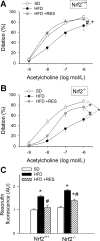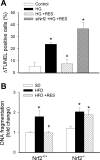Resveratrol confers endothelial protection via activation of the antioxidant transcription factor Nrf2
- PMID: 20418481
- PMCID: PMC2904129
- DOI: 10.1152/ajpheart.00260.2010
Resveratrol confers endothelial protection via activation of the antioxidant transcription factor Nrf2
Abstract
Epidemiological studies suggest that Mediterranean diets rich in resveratrol are associated with reduced risk of coronary artery disease. Resveratrol was also shown to confer vasoprotection in animal models of type 2 diabetes and aging. However, the mechanisms by which resveratrol exerts its antioxidative vasculoprotective effects are not completely understood. Using a nuclear factor-E(2)-related factor-2 (Nrf2)/antioxidant response element-driven luciferase reporter gene assay, we found that in cultured coronary arterial endothelial cells, resveratrol, in a dose-dependent manner, significantly increases transcriptional activity of Nrf2. Accordingly, resveratrol significantly upregulates the expression of the Nrf2 target genes NAD(P)H:quinone oxidoreductase 1, gamma-glutamylcysteine synthetase, and heme oxygenase-1. Resveratrol treatment also significantly attenuated high glucose (30 mM)-induced mitochondrial and cellular oxidative stress (assessed by flow cytometry using MitoSox and dihydroethidine staining). The aforementioned effects of resveratrol were significantly attenuated by the small interfering RNA downregulation of Nrf2 or the overexpression of Kelch-like erythroid cell-derived protein 1, which inactivates Nrf2. To test the effects of resveratrol in vivo, we used mice fed a high-fat diet (HFD), which exhibit increased vascular oxidative stress associated with an impaired endothelial function. In HFD-fed Nrf2(+/+) mice, resveratrol treatment attenuates oxidative stress (assessed by the Amplex red assay), improves acetylcholine-induced vasodilation, and inhibits apoptosis (assessed by measuring caspase-3 activity and DNA fragmentation) in branches of the femoral artery. In contrast, the aforementioned endothelial protective effects of resveratrol were diminished in HFD-fed Nrf2(-/-) mice. Taken together, our results indicate that resveratrol both in vitro and in vivo confers endothelial protective effects which are mediated by the activation of Nrf2.
Figures




Comment in
-
Endothelial Nrf2 activation: a new target for resveratrol?Am J Physiol Heart Circ Physiol. 2010 Jul;299(1):H10-2. doi: 10.1152/ajpheart.00436.2010. Epub 2010 May 14. Am J Physiol Heart Circ Physiol. 2010. PMID: 20472762 Free PMC article. No abstract available.
References
-
- Baur JA, Pearson KJ, Price NL, Jamieson HA, Lerin C, Kalra A, Prabhu VV, Allard JS, Lopez-Lluch G, Lewis K, Pistell PJ, Poosala S, Becker KG, Boss O, Gwinn D, Wang M, Ramaswamy S, Fishbein KW, Spencer RG, Lakatta EG, Le Couteur D, Shaw RJ, Navas P, Puigserver P, Ingram DK, de Cabo R, Sinclair DA. Resveratrol improves health and survival of mice on a high-calorie diet. Nature 444: 337–342, 2006 - PMC - PubMed
-
- Baur JA, Sinclair DA. Therapeutic potential of resveratrol: the in vivo evidence. Nat Rev Drug Discov 5: 493–506, 2006 - PubMed
-
- Chen CY, Jang JH, Li MH, Surh YJ. Resveratrol upregulates heme oxygenase-1 expression via activation of NF-E2-related factor 2 in PC12 cells. Biochem Biophys Res Commun 331: 993–1000, 2005 - PubMed
-
- Chow SE, Hshu YC, Wang JS, Chen JK. Resveratrol attenuates oxLDL-stimulated NADPH oxidase activity and protects endothelial cells from oxidative functional damages. J Appl Physiol 102: 1520–1527, 2007 - PubMed
Publication types
MeSH terms
Substances
Grants and funding
LinkOut - more resources
Full Text Sources
Medical
Molecular Biology Databases
Research Materials
Miscellaneous

